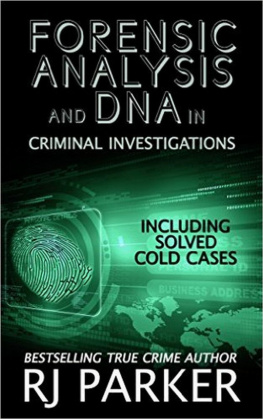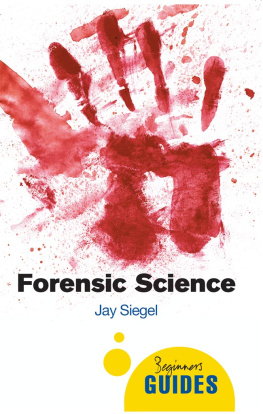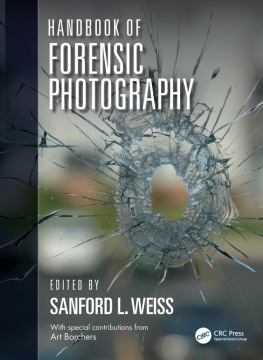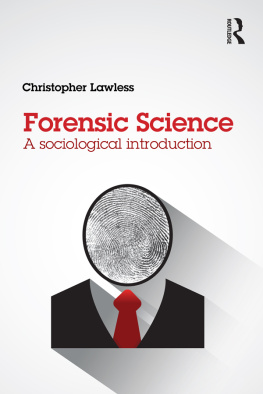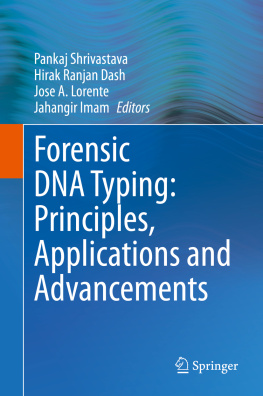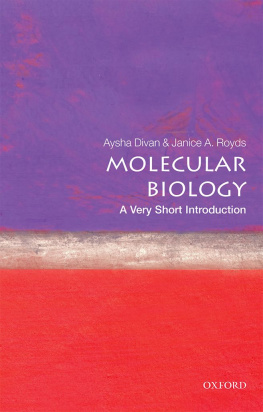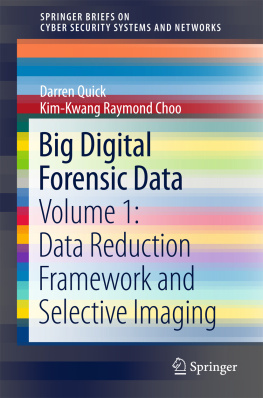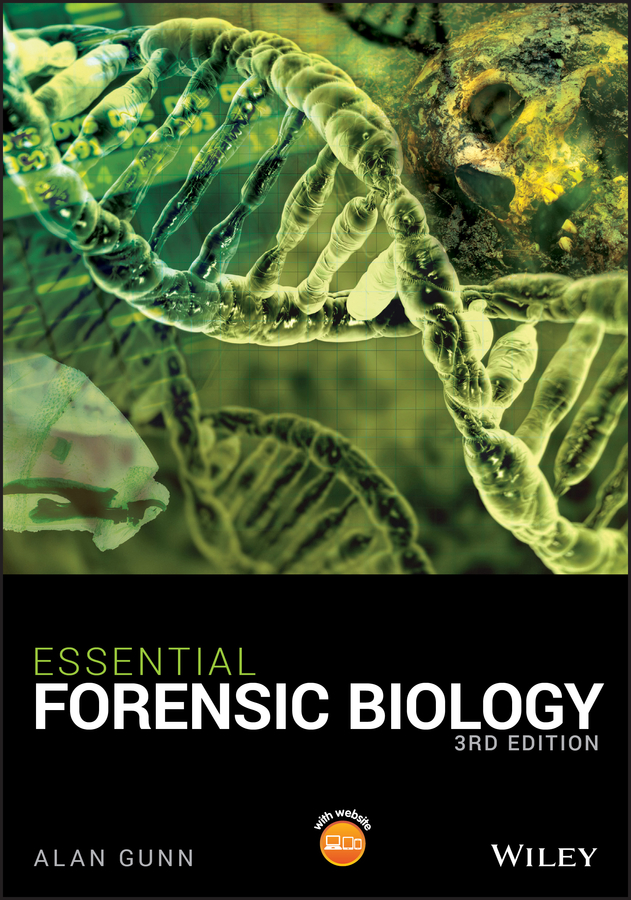
Table of Contents
List of Tables
- f04
- Chapter 1
- Chapter 2
- Chapter 3
- Chapter 4
- Chapter 5
- Chapter 6
- Chapter 7
- Chapter 8
- Chapter 9
- Chapter 10
- Chapter 11
- Chapter 12
- Chapter 13
List of Illustrations
- Chapter 1
- Chapter 3
- Chapter 4
- Chapter 6
- Chapter 7
- Chapter 8
- Chapter 9
- Chapter 10
- Chapter 11
- Chapter 12
Guide
Pages
Essential Forensic Biology
Third Edition
Alan Gunn
School of Natural Sciences & Psychology
Liverpool John Moores University
UK

This edition first published 2019
2019 John Wiley & Sons Ltd
Edition History
1e 2006 Wiley, 2e 2009 Wiley
All rights reserved. No part of this publication may be reproduced, stored in a retrieval system, or transmitted, in any form or by any means, electronic, mechanical, photocopying, recording or otherwise, except as permitted by law. Advice on how to obtain permission to reuse material from this title is available at http://www.wiley.com/go/permissions.
The right of Alan Gunn to be identified as the author of this work has been asserted in accordance with law.
Registered Offices
John Wiley & Sons, Inc., 111 River Street, Hoboken, NJ 07030, USA
John Wiley & Sons Ltd, The Atrium, Southern Gate, Chichester, West Sussex, PO19 8SQ, UK
Editorial Office
The Atrium, Southern Gate, Chichester, West Sussex, PO19 8SQ, UK
For details of our global editorial offices, customer services, and more information about Wiley products visit us at www.wiley.com.
Wiley also publishes its books in a variety of electronic formats and by printondemand. Some content that appears in standard print versions of this book may not be available in other formats.
Limit of Liability/Disclaimer of Warranty
In view of ongoing research, equipment modifications, changes in governmental regulations, and the constant flow of information relating to the use of experimental reagents, equipment, and devices, the reader is urged to review and evaluate the information provided in the package insert or instructions for each chemical, piece of equipment, reagent, or device for, among other things, any changes in the instructions or indication of usage and for added warnings and precautions. While the publisher and authors have used their best efforts in preparing this work, they make no representations or warranties with respect to the accuracy or completeness of the contents of this work and specifically disclaim all warranties, including without limitation any implied warranties of merchantability or fitness for a particular purpose. No warranty may be created or extended by sales representatives, written sales materials or promotional statements for this work. The fact that an organization, website, or product is referred to in this work as a citation and/or potential source of further information does not mean that the publisher and authors endorse the information or services the organization, website, or product may provide or recommendations it may make. This work is sold with the understanding that the publisher is not engaged in rendering professional services. The advice and strategies contained herein may not be suitable for your situation. You should consult with a specialist where appropriate. Further, readers should be aware that websites listed in this work may have changed or disappeared between when this work was written and when it is read. Neither the publisher nor authors shall be liable for any loss of profit or any other commercial damages, including but not limited to special, incidental, consequential, or other damages.
Library of Congress CataloginginPublication Data
Names: Gunn, Alan, author.
Title: Essential forensic biology / Alan Gunn.
Description: Third edition. | Hoboken, NJ : John Wiley & Sons, 2019. | Includes bibliographical references and index. |
Identifiers: LCCN 2018024347 (print) | LCCN 2018032407 (ebook) | ISBN 9781119141419 (Adobe PDF) | ISBN 9781119141426 (ePub) | ISBN 9781119141402 (pbk.)
Subjects: LCSH: Forensic biology.
Classification: LCC QH313.5.F67 (ebook) | LCC QH313.5.F67 G86 2018 (print) | DDC 363.25/62dc23
LC record available at https://lccn.loc.gov/2018024347
Cover Design: Wiley
Cover Images: DNA molecules Svisio/iStock.com, Human skull in concept Lipowski/iStock.com, Genetic DNA research Pgiam/iStock.com, Maggot image provided by Alan Gunn
To Sarah, who believes that no evidence is required in order to find a husband guilty.
Introduction
The word forensic derives from the Latin forum meaning a market place: in Roman times, the forum was where people conducted business transactions and some legal proceedings. For many years, the term forensic had a restricted definition and denoted a legal investigation. However, nowadays it applies to any detailed analysis of past events, i.e. when one looks for evidence. For example, tracing the source of a pollution incident is now a forensic environmental analysis, determining past planetary configurations is forensic astronomy, whilst forensic musicology refers to the comparison of two pieces of music in cases of alleged copyright infringement. For the purposes of this book, forensic biology is defined broadly as the application of biological sciences to legal investigations and therefore covers human anatomy and physiology, viruses to vertebrates and topics from murder to the trade in protected plant species.
Although forensic medicine and forensic science only became specialised areas of study within the last 200 or so years, their origins are traceable back to the earliest civilisations. The first person in recorded history to have medicolegal responsibilities was Imhotep, Grand Vizier, Chief Justice, architect and personal physician to the Egyptian pharaoh Zozer (or Djoser). Zozer reigned from 2668 to 2649BC and charged Imhotep with investigating deaths occurring under suspicious circumstances. The Sumerian king UrNammu (ca 2060BC) began the first codification of laws with the eponymous UrNammu Code, in which penalties of various crimes were stipulated. The first record of a murder trial appears on clay tablets inscribed in 1850BC at the Babylonian city of Nippur.
In England, the office of coroner dates back to the era of Alfred the Great (871899), although his precise functions at this time remain uncertain. It was during the reign of Richard I (11891199) that the coroner became an established figure in the legal system. The early coroners had widespread powers and responsibilities that included the investigation of crimes ranging from burglary to murder and suspicious death. The body of anyone dying unexpectedly had to be kept for inspection by the coroner, even if the circumstances were not suspicious. Failure to do so meant that those responsible for the body were fined, even though it might have putrefied and created a noisome stench by the time he arrived. It was therefore common practice for unwanted bodies to be dragged away at night to become another village's problem. The coroner's responsibilities changed considerably over the centuries, but up until 1980, he was required to view the body of anyone dying in suspicious circumstances.
Although the coroner was required to observe the corpse, he did not undertake an autopsy. In England and other European countries, dissection of the human body was considered sinful and was banned or permitted only in exceptional circumstances until the nineteenth century. Most Christians believed that after a person died, their body had to be buried whole. If it was not, the chances of material resurrection on Judgement Day were slight. The first authorised human dissections took place in 1240, when the Holy Roman Emperor Frederick II decreed that a corpse could be dissected at the University of Naples every five years to provide teaching material for medical students. Subsequently, other countries followed suit, albeit slowly. In 1540, King Henry VIII became the first English monarch to legislate for the provision of human dissections by permitting the Company of Barber Surgeons to examine the corpses of four dead criminals per annum. In 1663, King James II increased this figure to six per annum. Subsequently, after passing the death sentence, judges had the option of decreeing the body of the convict to be buried (albeit without ceremony), or exposed on a gibbet or dissected. Nevertheless, the lack of bodies and an eager market among medical colleges created the trade of body snatching. Body snatchers usually left behind the coffin and the burial shroud, because taking these counted as a serious criminal offence which was potentially punishable by hanging. Removing a body from its grave was merely a misdemeanour. The modernday equivalent is the Internet market in human bones of uncertain provenance. A notorious case arose in 2004 when the body of the eminent journalist Alistair Cooke was plundered whilst resting in a funeral parlour in New York. Despite being 95years old at the time of his death and suffering from cancer, his arms, legs, and pelvis were surreptitiously removed. These were then sold to a tissue processing company for use in surgery or as dental filler. The trade in human bones is legal provided the correct protocols are followed, but it is also highly lucrative and this tempts some people into criminal behaviour.
Next page

